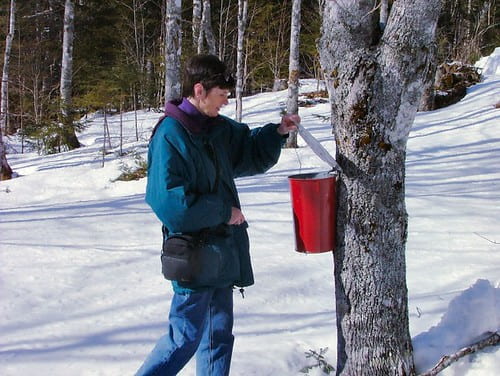Maple Days was a great success again this early December with a wonderful slate of speakers, and we matched last year’s attendance despite landing on the weekend of Ohio’s deer gun season to which reason we lacked a score or more of regular attendees.

On Friday afternoon, Ohio State’s David Marrison (Farm Management Field Specialist) and Robert Moore (OSU Agricultural and Resource Law Program Attorney) hosted 42 people in an Estate Planning workshop. Attendees were coached through the challenging but necessary process of planning for the future. Intentionally planning one’s own legacy can be a daunting task, but the workshop is designed around just that process – actively planning for the future of one’s farm, or for many peoples’ cases – one’s sugarhouse. The event received enthusiast reviews from both participants and hosts alike.
December 7th was the Saturday main event. Things kicked off with a talk from Keith Libben from Ohio’s Department of Agriculture. Much ado has been made of the Natural Resource Conservation Service’s technical and cost-share assistance for sugarmakers, but this year’s talk from Keith featured some fantastic success stories that producers could easily connect with. A big thanks to Jen Freeman for assembling an all-star panel that discussed all things filtering, sap storage, and syrup bottling…and I mean all things. The amount of depth and breadth that was covered in that hour was astounding, and the steady flow of questions and comments from the audience was a great indicator of a great session. A series of maple-related wildlife updates reminded the audience that wildlife are a true Jekyll and Hyde of the sugarbush.
Bridging the morning session into the afternoon announcements of the John Berry Maple Syrup Contest was a talk on USDA syrup standards and grading. The interactive elements of that session were a clear testament to the fact that while the basics of grading are well understood, practice makes perfect even for the most experienced of maple producers. And speaking of maple syrup contests, here’s a rundown of the deserving 2024 winners!


Delicate: No entries qualified, there’s your chance for next year folks!
Amber: 1st – Bruce Kavanaugh, 2nd – Aggie Sojka-Sperry
Dark: 1st – Ohio State University-Mansfield, 2nd – Bonhomie Acres, 3rd – Aggie Sojka-Sperry
Very Dark: 1st – Charles Hammer, 2nd – Bonhomie Acres, and 3rd – Ohio State University-Mansfield

The Dick Schoor Small Producer Award went to Bruce Kavanaugh, and Dan and Kelly Brown from Bonhomie Acres took the Hilton Farley Best-of-Show Award. A People’s Choice contest was well worth the extra effort to set up, and lots of folks participated. The Browns with Bonhomie Acres claimed the Delicate category, Dave and Christina Remy won by popular vote in the Amber and Dark grades, and Gay & Galen Smith with Double G Maple took the Very Dark category. We hope participation in the John Berry Maple Syrup Contest continues to grow as the competition grading now incorporates a phenomenal opportunity to glean feedback on your syrup’s grade, color, clarity, density, and flavor thanks to a new form crafted by Jake Nicholson and adapted from forms used in syrup contests elsewhere.

Zac Smith from University of Vermont anchored the afternoon session with a presentation on marketing strategies for maple producers. We look forward to hosting the UVM team back in 2025 to talk more about the consumer part of the marketing equation. Always good to have our friends visit from the north woods.
The afternoon session split led part of the audience through a couple of talks focused on managing a timber sale and safe chainsaw operation and maintenance. Paul Helser from Helser Woodland Management and Lee Beers of OSU Extension – thank you for a great afternoon session. The other room explored solar as not only a green alternative option to conventional electricity but also as a way to get power into tough-to-reach areas of the woods. Les Ober also shared a great talk on handling sap from the logical point of origin – the tree! – all the way to the evaporator. This talk was similar to the panel session from the morning in that there was at least one tip or trick to be gleaned for even the most experienced maple producer in the room.

It would be crazy not to acknowledge the excellent menu presented by the Ashland University culinary team – from dark beer braised beef to maple candied brussel sprouts and a line-up of desserts to drool over, lunch remains a highlight of the overall Ohio Maple Days experience for all. As much as we’ve come to count on delicious eats at the conference, we are also glad to offer free hydrometer testing as a mainstay of the event as well. Almost 20% of attendees brought hydrometers to be tested with many producers bringing upwards of a half dozen instruments.


As a tip of the hat to the next generation, we also want to recognize Ms. Elizabeth Franz who came back to this year’s conference to present her research poster on nitrate and phosphate occurrence in maple syrup. A big thanks to the maple producers who stepped up to the plate as collaborators in her work last year. As great as events like Maple Days are, they won’t guarantee a vibrant future for the maple industry in Ohio, but continued involvement of and investment in the next generation will!






















